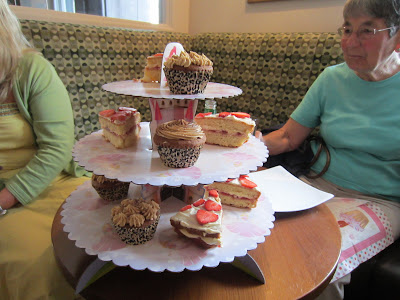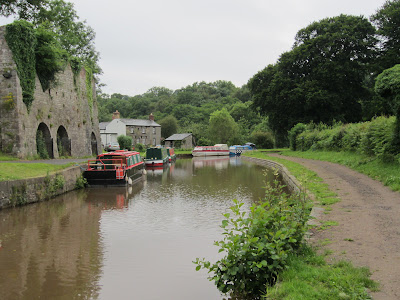July 8, 2012
This morning we headed off north and west in the direction of Aberystwyth, Wales. One of Rowan's childhood friends, Ursula, owns an award winning pub here, so we will stop to have lunch. Rowan's dad has no idea we will be stopping at Ursula's pub, he has known her since she was a wee one. We drove through some stunningly beautiful country on the way north. Much of the landscape reminds me of Marin and Sonoma counties in California. So much green it just blows your mind.
They offer a five pump platter here at The Ship & Castle. This is five different 1/2 pints of beer as a sampler. Perfect for the lad who just can't decide what to have!
Here is what it looks like without the beer. You can see they have many kinds of beer on draft.
We went through one region of the park where the mountains were made from slate. The slate rocks raining down the mountains were incredible. It was like this for miles. All the slate from the world must come from here. No wonder slate is used as a building material, from roofs to walls, here in the UK.
This morning we headed off north and west in the direction of Aberystwyth, Wales. One of Rowan's childhood friends, Ursula, owns an award winning pub here, so we will stop to have lunch. Rowan's dad has no idea we will be stopping at Ursula's pub, he has known her since she was a wee one. We drove through some stunningly beautiful country on the way north. Much of the landscape reminds me of Marin and Sonoma counties in California. So much green it just blows your mind.
A view of the Irish Sea in Aberystwyth
We arrived in Aberystwyth in early afternoon. This is a university town, home of a University of Wales campus. Go here for interesting information about this seaside town: http://www.aberystwyth.com/
Dad was really surprised when we pulled up and went into the pub and there was Ursula and her husband Ian. The pub wasn't even open yet, but she had arranged to give us a private lunch. She had lovely sandwiches and treats prepared for us. Oh, and of course a pint to wet our parched throats :o)They offer a five pump platter here at The Ship & Castle. This is five different 1/2 pints of beer as a sampler. Perfect for the lad who just can't decide what to have!
Here is what it looks like without the beer. You can see they have many kinds of beer on draft.
Rowan with Ursula and Ian and their family outside the pub.
Our ultimate destination today is Beaumaris, Anglesey, more north and west of where we currently are, so after lunch we hit the road again. I did take some photos/movies on our way out of Aberystwyth so you all could see more of this cute seaside town.
OK, so here is a wonderful example of what the Welsh language looks like. English- The Salvation Army. Welsh - all that stuff that is next! :o) All of the signs in Wales are like this. We will give you a welsh lesson in the next post.
As we traveled north, we drove through the region known as Snowdonia National Park. The park covers an area of 838 square miles. This was the first area in Wales designated as a national park back in 1951. The park includes public and private lands within its boundaries and is named after it's tallest mountain, Snowdon. Approximately 62% of the people in this region speak Welsh (oh boy, this should be fun!). The mountains are very dramatic and make for some outstanding views.
Go here for a good map of where we are: http://www.eryri-npa.gov.uk/park-authority/offices
It was hard to get really good photos of our drive through the mountains as it began to get misty and rainy, so I got some photos from the internet to show you too.
Photos from the car......
We went through one region of the park where the mountains were made from slate. The slate rocks raining down the mountains were incredible. It was like this for miles. All the slate from the world must come from here. No wonder slate is used as a building material, from roofs to walls, here in the UK.
Beaumaris, Anglesey is next. Stay tuned..........






























































